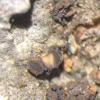
21-12-2025 09:32
Hello.A tiny ascomycete found embedded in wood in

21-12-2025 21:32
Pol DebaenstHello, Garden, Burgweg 19, Veurne, BelgiumOn 10/1

22-12-2025 23:38
Patrice TANCHAUDBonsoir, récolte sur un mur en pierre, apothéci

22-12-2025 00:47
Patrice TANCHAUDBonsoir, récolte à proximité du milieu dunaire

21-12-2025 21:40
Isabelle CharissouBonjour, j'aimerais connaitre les références de

21-12-2025 21:31
Pol DebaenstHello, Garden, Burgweg 19, Veurne, BelgiumOn 10/1

21-12-2025 21:31
Pol DebaenstHello, Garden, Burgweg 19, Veurne, BelgiumOn 10/1

20-12-2025 23:08
Patrice TANCHAUDBonsoir, récolte sur sol sablonneux dans l'arri�
 Dear forum,
Dear forum,I would like to ask about your experience with Dermea tulasnei. So far I've seen mostly single collections published for the UK (Dennis), France (Ayel et Van Vooren), Spain (Rubio), Danmark (Læssøe), Poland (Ginko) and western part of Russia (Popov et Volobuev). I wonder whether it's rarely collected, rarely looked for, or just rarely published.
Does it grow in your country too? How frequent is it there? Did you find it on other ash than F. excelsior or higher than 250 m asl? In what kind of habitat? Did you identify the fungus that often causes black-coloured bark around fruitbodies?
The reason for my questions are six czech collections from last 12 months, one of them on F. angustifolia. Most are from lowland riparian forests (180-220 m asl) with variable air humidity, shrub layer abundantly present or entirely absent, one is even from a city park. My hypothese is that its occurence might be positively influenced by the ash dieback spreading during last decades that continuously provides a lot of fresh substrate.
Thank you for any opinions.
Viktorie

I have 3 coll. in my database. Two are very old (1988) and from a single spot in Luxembourg (Tuntange) by Guy on F. excelsior. I have sketches but not yet scanned. One is by Christian Lechat near Rimont (Pyrenees). For this latter I have photos (HB 8213) in my folder. I never collected it myself.
Zotto

thank you very much for your data. It's an interesting addition, the Las Muros place near Rimont could be some 450-500 m alt. and Tuntange would be around 350 m, much higher than here but I guess the climate there could be influenced by the see.
Viktorie

Luxembourg is a bit subatlantic but not much as far as I know.


thank you very much for sharing your collection data. Was it always on freshly fallen branches, or also at a later stage of decay? Were there any other fungi growing together with Dermea?
Best regards,
Viktorie

 Dermea-tulasnei-0001.pdf
Dermea-tulasnei-0001.pdf

